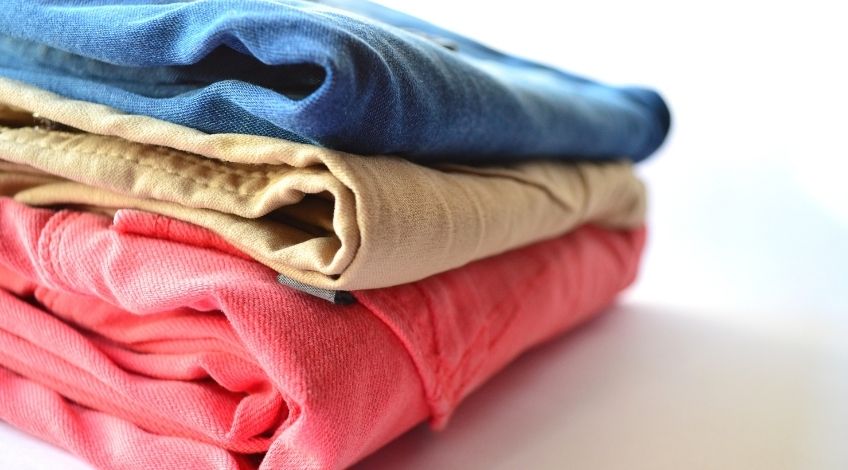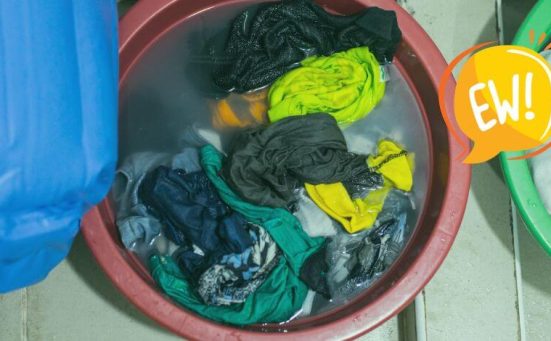
What’s The Minimum Temperature For Drying Clothes Outside?
There’s nothing better for drying clothes than to hang it on a washing line in the sunshine during those hot Summer months. Not only does the laundry dry quickly, but drying laundry outdoors allows any volatile organic compounds to evaporate. Chemicals from detergents, fabric conditioners, dyes etc will dissipate into the air.
The laundry comes in completely dry and smelling fresh within a very short while. But how about when the weather isn’t so good, in the depths of Winter? Is there a minimum temperature for drying clothes outside?
What Is The Minimum Temperature Needed To Dry Clothes Outside?
There is no minimum temperature needed to dry laundry outdoors, but there are certain conditions that need to be met.
It might surprise you to learn that there is no minimum temperature for drying clothes outside. It’s not just the temperature that causes clothes to dry on a washing line. There are other factors at play that cause wet washing to dry. For clothes to dry they need 3 things;
- Sunshine
- Wind
- Low Humidity
Or to put it another way, for clothes to dry outdoors they need warmth, and air dryer than the clothes along with movement.
How Does This Work In Winter?
We often get dry, sunny days even in the Winter. Granted those days are often cold enough to freeze the water on the bird bath. But as long as the air is dry, the sun is shining and there’s a breeze (or more likely a wind), washing will eventually dry on a washing line outdoors.
You’ll need to keep your eye on the forecast and the actual weather, but as long as those 3 conditions are met, it is possible to dry washing outdoors during Winter months.
Obviously if it’s raining or snowing, the washing won’t dry and in such conditions you’ll need to find another option. If you don’t like using a tumble dryer, then an airer indoors might be an option. Take care though because there can be health implications drying washing indoors.
What Are The Health Implications Of Drying Laundry Indoors?
If you decide to dry your laundry indoors over radiators for example, those volatile organic compounds (VOCs) we mentioned earlier will be released into the air inside your home. These VOCs have been linked to a number of detrimental health conditions from minor eyes, nose and throat irritations to more serious headaches, nausea, kidney and liver damage, damage to the central nervous system and even cancer according to the Minnesota Pollution Control Agency[1].
As if this wasn’t bad enough, the moisture that leaves the clothes has to go somewhere. Which means that drying laundry indoors increases the overall humidity of your home by as much as 30% according to Medical News Today[2]. This can lead to the growth of mould spores which are known to exacerbate asthma, bronchitis, sinusitis, fatigue as well as many other irritations.
How To Dry Washing Outdoors In Winter

The only equipment needed is an outdoor washing line to allow any breeze to agitate the laundry. To dry washing outdoors in Winter you should;
- Ensure the laundry is as dry as possible
Use the highest spin speed on your washing machine to extract as much water as possible to give the laundry a better chance of drying. - Hang laundry on the washing line
Allow extra space between items and spread the garments out as fully as possible to expose the maximum surface area possible. - Hang the laundry as early in the day as possible
This allows the laundry longer to dry by catching every ray of sunshine. - Watch the weather
Use the weather forecast to plan your washdays and dry washing during sunny periods.
It might be more convenient to use a drying rack outdoors during Winter months rather than a clothesline. This allows you to move the whole rack indoors in one swift movement if the weather turns instead of having to unpeg each item of clothing.
If the clothes aren’t fully dried by the time you need to bring them indoors, use an airer to finish them off. The clothes will release less VOCs and less water if they’ve been outside and partially dried.
Drying Laundry Indoors Safely
If the weather turns particularly wet and it is no longer possible to hang your laundry outdoors to dry. There are a number of things you can do to minimise the health risks involved with drying clothes indoors. You can;
- Dry laundry as much as possible by giving it an extra spin cycle in the washing machine
- Dry as much as possible outdoors before bringing the laundry indoors, every little helps
- Dry your laundry in a well ventilated space, open a window or two to allow fresh air to circulate (this could be difficult during extreme weather)
- Place a dehumidifier near to the laundry to soak up as much moisture as possible
- Place very wet laundry in the kitchen or bathroom and make use of the extractor fan to remove VOCs and moisture from the air
- If it’s just waistbands and pockets that are still damp, use a hairdryer to finish them off
- Use natural washing detergents and softeners which will contain less harmful compounds (VOCs)
What Conditions Are Needed to Dry Laundry Outdoors?

The reality is that a cold, dry, sunny day will dry clothes quicker than a warm damp, humid, overcast day. But what are the ideal drying conditions for laundry outdoors?
According to Jim NR Dale, founder of the British Weather Services and Vileda[3] the perfect drying conditions are; 1 hour of sunlight with less than 70% humidity, a temperature of 21C(70F) or higher and between 8 to 12 MPH wind speed. Which pretty much describes a Summer’s day.
Which Is Great But What Does That Mean In Winter?
It basically means as long as the sun is shining, the wind is blowing and the humidity is less than the moisture content of the laundry, it will dry outdoors – eventually. In other words, given the correct conditions even at far lower temperatures, your laundry will dry outdoors, it’ll just take longer.
How Long Will It Take To Dry Laundry Outdoors In Winter?
As we have just seen, the amount of time needed to dry laundry outdoors is dependent on a number of factors. Assuming the weather conditions are correct, even at low temperatures, it is possible to dry laundry outdoors in the Winter. However the time needed will be greater, in some cases far greater.
In fact it can take up to 12 hours during Winter months to dry laundry outdoors. During mid Winter, we get around 7 hours of daylight (if we’re lucky) which means it could take 2 days to completely dry washing outdoors, but that’s in the right conditions.
Is It Better To Dry Clothes Outdoors?
It is always better, if possible, to dry clothes outdoors. As we said earlier, the moisture and potentially harmful VOCs will stay outdoors and not cause us any problems healthwise. Plus there’s the potential saving on energy costs which has become even more prominent in recent months.
In conclusion it is always better to dry laundry outdoors whenever possible.
Frequently Asked Questions
As long as the conditions are right, sunlight, plus dry air, plus a breeze, clothes will dry outside even in Winter. It can take more than 12 hours which could mean 2 or even 3 days outside.
You can dry your clothes outside at any time of the year as long as it is sunny and dry, even in mid Winter. All you need is the humidity of the air to be lower than the moisture content of the clothes and enough breeze to move the washing around on the line.
Clothes will dry in a cold garage as long as the humidity in the air is lower than the moisture content of the clothes. As the garage is cold, the clothes will dry but it will take longer than in a garden in full sun.
As long as the air is warm, dry and breezy, your clothes will dry outside at night.
Also, follow us on Pinterest ...



